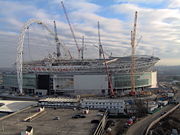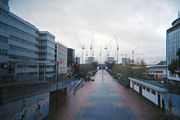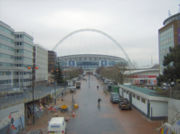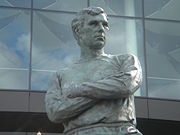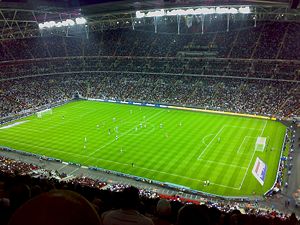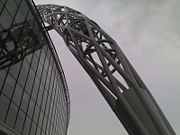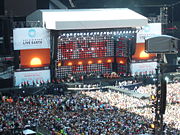Wembley Stadium
2008/9 Schools Wikipedia Selection. Related subjects: Architecture
| Wembley Stadium | |
|---|---|
Image:Wembley Stadium logo.png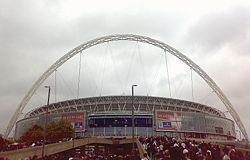 |
|
| Location | London, England |
| Broke ground | 2003 |
| Opened | 2007 |
| Owner | The Football Association |
| Operator | Wembley National Stadium Limited |
| Surface | Grass |
| Construction cost | GBP£778 million(2007) |
| Architect | Foster and Partners and HOK Sport |
| Tenants |
|
| Capacity |
75,000 seated and 15,000 standing (concerts) 68,400 to 72,000 (athletics) |
Wembley Stadium is a stadium in Wembley, located in the London Borough of Brent in London, England. It is owned by The Football Association (FA) via its subsidiary Wembley National Stadium Limited, and its primary use is for home games of the England national football team, and the main English domestic football finals. It is also used for pop concerts and other sporting events.
With 90,000 seats the stadium has the second largest capacity in Europe (after the Camp Nou), and the largest in the world with every seat under cover. Following its opening, it has often been referred to as the "new Wembley Stadium" to distinguish it from the original stadium. The stadium is also the most expensive stadium ever built.
The previous Wembley Stadium (originally known as the Empire Stadium) was one of the world's most famous football stadia, being England's national stadium for football, and because of the geographical origins of the game was often referred to as "The Home of Football". It hosted the European Cup (now the UEFA Champions League) final a record five times, and is one of seventeen stadia to have held a FIFA World Cup final. In 2003, the original structure was demolished and construction began on the new stadium, originally intended to open in 2006. This was later delayed until early 2007. The final completion date of the stadium came on 9 March 2007, when the keys to the stadium were handed over to the FA.
Building
Wembley was designed by architects HOK Sport and Foster and Partners with engineers Mott MacDonald, built by Multiplex and funded by Sport England, WNSL (Wembley National Stadium Limited), the Football Association, the Department for Culture Media and Sport and the London Development Agency. It is the most expensive stadium ever built at a cost of £798 million (roughly US$1.57 billion) and has the largest roof-covered seating capacity in the world.
The all-seater stadium is based around a bowl design with a capacity of 90,000, protected from the elements by a sliding roof. It can also be adapted as an athletic stadium by erecting a temporary platform over the lowest tier of seating. The stadium's signature feature is a circular section lattice arch of 7 m (23 ft) internal diameter with a 315 m (1,033 ft) span, erected some 22° off true, and rising to 140 m (459 ft) tall. It supports all the weight of the north roof and 60% of the weight of the retractable roof on the southern side. The archway is the world's longest unsupported roof structure. Instead of the 39 steps climbed, in the original stadium, to enter the Royal Box and collect a trophy, there are now 107.
A "platform system" has been designed to convert the stadium for athletics use, but its use would decrease the stadium's capacity to approximately 60,000. No athletics events have taken place at the stadium, and none are scheduled.
The stadium is linked to Wembley Park Station on the London Underground via Olympic Way, and Wembley Central via the White Horse Bridge. It also has a rail link—provided by the Wembley Stadium railway station—to London Marylebone and Birmingham.
The initial plan for the reconstruction of Wembley was for demolition to begin before Christmas 2000, and for the new stadium to be completed some time during 2003, but this work was delayed by a succession of financial and legal difficulties. It was scheduled to open on 13 May 2006, with the first game being that year's FA Cup Final. However, worries were expressed as to whether the stadium would actually be completed on time. The new stadium was completed and handed over to the FA on 9 March 2007, with the total cost of the project (including local transport infrastructure redevelopment and the cost of financing) estimated to be £1 billion (roughly US$1.97 billion).
In October 2005, Sports Minister Richard Caborn announced: "They say the Cup Final will be there, barring six feet of snow or something like that". However in December 2005, the builders admitted that there was a "material risk" that the stadium might not be ready in time for the Cup Final and in February 2006, these worries were confirmed by the FA moving the game to Cardiff's Millennium Stadium.
The delays started as far back as 2003. In December 2003, the constructors of the arch, subcontractors Cleveland Bridge, warned Multiplex about rising costs and a delay on the steel job of almost a year due to design changes which Multiplex rejected. Cleveland Bridge were removed from the project and replaced by Dutch firm Hollandia with all the attendant problems of starting over. On 20 March 2006, a steel rafter in the roof of the new development fell by a foot and a half, forcing 3,000 workers to evacuate the stadium and raising further doubts over the completion date which was already behind schedule. On 23 March 2006, sewers beneath the stadium buckled due to ground movement. GMB Union leader Steve Kelly said that the problem had been caused by the pipes not being properly laid, and that the repair would take months. A spokesman for developers Multiplex said that they did not believe this would "have any impact on the completion of the stadium", which was then scheduled to be completed on 31 March 2006.
On 30 March 2006, the developers announced that Wembley Stadium would not be ready until 2007. All competitions and concerts planned were to be moved to suitable locations. On 19 June 2006 it was announced that the turf had been laid. On 19 October 2006 it was announced that the venue was now set to open in early 2007 after the dispute between The Football Association and Multiplex had finally been settled. WNSL, a subsidiary of The Football Association, is expected to pay around £36m to Multiplex, as well as the amount of the original fixed-price contract. This meant that the Wembley Stadium was ready for the 2007 FA Cup Final on 19 May 2007. The official Wembley Stadium website announced that the stadium would be open for public viewing for local residents of Brent on 3 March 2007, however the event was delayed by two weeks and instead happened on 17 March. The keys to the new Wembley stadium were finally handed over to the owners on 9 March 2007 ready to be open and used for upcoming FA Cup football matches, concerts and other events.
A short documentary of its redevelopment can be found on the Queen Live at Wembley 1986 DVD. The reconstruction of the stadium is part of the wider regeneration of Wembley.
Although not completed or opened at the time, EA Sports added Wembley Stadium into the video game FIFA 07.
A statue of Bobby Moore—the captain of the England national football team when they won the 1966 Football World Cup at Wembley—was unveiled outside the stadium on Friday May 11, 2007.
Structure
- With 90,000 seats, the new Wembley is the largest stadium in the world with every seat under cover. This capacity is separated into 3 tiers of seating, with the lower tier holding 34,303 spectators, the middle one 16,932 and the upper one 39,165
- The stadium contains 2,618 toilets, more than any other venue in the world.
- The stadium has a circumference of 1 km (0.6 mi).
- At its peak, there were more than 3,500 construction workers on site.
- 4,000 separate piles form the foundations of the new stadium, the deepest of which is 35 m (115 ft).
- There are 56 km (35 miles) of heavy-duty power cables in the stadium.
- 90,000 m³ (120,000 cu yds) of concrete and 23,000 tonnes (25,000 short tons) of steel were used in the construction of the new stadium.
- The total length of the escalators is 400 m (¼ mi).
- The Wembley Arch has a diameter greater than that of a cross-channel train.
Pitch
The new pitch is 4 m (13 ft) lower than the previous pitch. The pitch size is 105 m (115 yards) long by 68 m (75 yards) wide, slightly narrower than the old Wembley Since the completion of the new Wembley, the pitch has come into major disrepute when it was commented on being "no good" and "not in the condition that Wembley used to be known for" by Slaven Bilić before the game between England and the team he managed, Croatia. It was confirmed when the pitch was terribly cut up during the game, which was blamed by some as the reason England did not qualify for UEFA Euro 2008 despite previous results also being blamed by others.
Roof
The new 6,350 tonne roof covers an area of over 45,000 square metres (11 acres), four acres of which are movable and rise to 52 m (170 ft) above the pitch. With a span of 317 m (1040 ft), the arch is the longest single span roof structure in the world and is 134 m (440 ft) above the level of the external concourse, which is designed not to cast a shadow on the pitch.
Seating
There is more leg room in every seat than there was in the Royal Box of the old stadium.
Tenants
The English national football team will be a major user of Wembley Stadium. Given the ownership by The Football Association as of March 10, 2007, the League Cup final will move back to Wembley from Cardiff as the FA Cup final has. Other showpiece football matches that were previously staged at Wembley, such as the Football League promotion play-offs and the Football League Trophy final, have returned to the stadium, as has the Nationwide Conference play-off final. Additionally, the Rugby League Challenge Cup final will return to Wembley Stadium beginning in 2007.
The new Wembley is a significant part of the plan for the 2012 Summer Olympics to be held in London; the stadium will be the site of several games in both the men's and women's football tournaments, with the finals planned to be held there.
The Guinness Premiership reportedly discussed staging the London Double Header, usually held at Twickenham, at Wembley during the 2007-08 season. The double header involves four clubs, London Irish, Wasps, Saracens and Harlequins. Ultimately, however, the game was played at Twickenham.
On October 28, 2007, Wembley played host to the first competitive NFL regular season game ever to be played in Europe. The New York Giants defeated the Miami Dolphins 13-10. The first 40,000 tickets sold out in 90 minutes. The NFL has since announced plans to stage a second UK game in 2008. Wembley is one of a number of stadiums apparently in contention to host the game.
The Race of Champions also staged their 2007 event at the stadium on December 16th 2007.
Music
Besides football, Wembley can be configured to hold many other events, particularly major concerts. Muse performed two concerts on 16 June and 17 June, completely selling out the new venue with a capacity crowd of 134, 457. The Concert for Diana, a memorial concert ten years after the death of the Princess of Wales, took place on July 1, 2007. Metallica performed at the stadium on 7th July 2007 as part of the Live Earth concerts, and again the following day on 8th July.
- George Michael - June 9, 2007 (The first concert performance at the New Wembley Stadium)
- George Michael - June 10, 2007
- Muse - June 16, 2007 (Originally the first scheduled performance at the New Wembley Stadium and the first performance to sell out)
- Muse - June 17, 2007
- Concert for Diana - July 1, 2007
- Live Earth - July 7, 2007
- Metallica - July 8, 2007
- Foo Fighters - June 6, 2008
- Foo Fighters - June 7, 2008
In addition, the new Wembley Stadium is known for playing O Fortuna at many sporting events.
Firsts at the new Wembley Stadium
Football
- The first game was Geoff Thomas Foundation Charity XI and the Wembley Sponsors Allstars on March 17. The Geoff Thomas Foundation Charity XI won 2-0 (scorers Mark Bright and Simon Jordan). The first person to score at the new stadium was Mark Bright.
- The first official match involving professional players staged at the new stadium was England U21s vs Italy U21s on March 24, 2007, which finished 3-3. Official attendance was 55,700 (although all of the 60,000 tickets that were made available were sold in advance). This now stands as the record for the largest under-21 attendance ever.
- The first footballer to score in a FIFA sanctioned match was Italian striker Giampaolo Pazzini after 28 seconds of the same game between England U21 and Italy U21. Pazzini went on to score twice more in the second half of the match making him the first person to score a hat-trick at Wembley Stadium since Paul Scholes for England in 1999. This gives Pazzini two other records, the fastest goal scored at Wembley (old or new stadium) and the first person to score a hat-trick at the new Wembley. The first English player to score in a full-scale match was David Bentley with a free kick in the same game.
- The first penalty saved and first red card came in the Conference playoff final between Exeter City and Morecambe. The penalty was saved by Paul Jones of Exeter City from Morecambe striker Wayne Curtis. The red card was given to Matthew Gill of Exeter for a headbutt on Craig Stanley of Morecambe.
- The first club game, competitive game, and cup final held at the new Wembley took place on Saturday 12 May 2007 when Kidderminster Harriers met Stevenage Borough in the FA Trophy final. Kidderminster striker James Constable was the first player to score a goal in a final at the new Wembley in the FA Trophy Final. Kidderminster became the first team to play at both the old and new stadium. The game had a capped capacity of 80,000, and although allocations were between 15,000 and 20,000 for each club, the capacity reached 53,262. Stevenage Borough were the first team to win a final at the new Wembley beating Kidderminster 3-2, despite trailing 2-0 at half time.
- The first players to play at both the old and new Wembley stadia were Steve Guppy (for Stevenage Borough) and Jeff Kenna (for Kidderminster Harriers). Ex-England international Guppy was the first player to win a final at both stadia.
- The first ever FA Cup Final at the new Wembley (between Manchester United and Chelsea) was on Saturday 19 May 2007. Chelsea won 1-0 with a goal by Didier Drogba, making him the first player ever to score in the FA Cup final at the new Wembley. Chelsea were the last winners of the cup final at the old Wembley and the first winners at the new.
- The first game involving the full English national team was an international friendly played on June 1, 2007, against Brazil. The match saw captain John Terry become the first England international goal scorer at the new stadium when he scored in the 68th minute. Diego became the first international player for a visiting team when he scored in stoppage time, with the fulltime result being England 1-1 Brazil
- The first defeat of the English national team occurred on August 22, 2007, in a friendly match against German national team. This 2nd game in new Wembley ended 1-2.
- The first competitive senior international was played on September 8, 2007 between England and Israel. This game ended 3-0.
- The first player to score international goals at both the old and new stadiums was Michael Owen when he scored for England against Israel in the Euro 2008 qualifier on September 8th 2007.
- League Two Playoff (between Bristol Rovers F.C. and Shrewsbury Town F.C.) took place at Wembley on May 26, 2007. Bristol Rovers won the game 3-1 with goals Richard Walker 21, 35, Sammy Igoe 93. Stewart Drummond, Shrewsbury Town F.C. scored the first ever goal by a Football League club at the stadium after 3 minutes. A record League Two play off crowd of 61,589 witnessed the game, its also the highest crowd for any League Two/ fourth tier match.
- Championship Playoff (between Derby County F.C. and West Bromwich Albion F.C.) took place at Wembley on May 28, 2007. Derby won the game 1-0 with a goal in the 61st minute by Stephen Pearson. This secured Derby a place in the Premiership as well as an expected £60million windfall, consisting of payments from TV rights, and increased gate receipts and sponsorship.
- On August 22nd Germany beat England 2-1, becoming the last team to beat England in "Old Wembley" and the first team to beat them in the new Wembley Stadium
- The first ever Community Shield at Wembley was played on 5 August between Manchester United and Chelsea. The score ended 1-1, but Manchester United won the first ever penalty shoot out at Wembley, 3-0.
- England's first competitive defeat at the new stadium was on November 21, 2007 when Croatia beat England 3-2. This match cost England qualification to Euro 2008 and head coach Steve McClaren his job.
- Sven-Goran Eriksson is the only England manager not to lead out a team at Wembley. Fabio Capello will become England's first foreign manager at Wembley in February 2008 against Switzerland
Rugby league
- When Catalans Dragons played St Helens in the 2007 Challenge Cup Final on 25 August, they became the first non-English rugby league team to play in the final. The result saw St Helens retain the cup by a score of 30-8.
- The first Rugby League team to win a game at the new Wembley Stadium, were in fact Castleford High School. The West Yorkshire secondary school beat Normanton in the Year 7 Carnegie Champion Schools final, which was played immediately prior to the 2007 Challenge Cup Final. The two West Yorkshire sides played in front of a crowd largely made up of people from their own county as thousands of Leeds Rhinos, Bradford Bulls, Wakefield Trinity Wildcats and Huddersfield Giants fans turned up despite their teams failing to qualifying for the final.
- The first official try at Wembley was scored by James Roby of St Helens, although there had been several tries scored in the schools game that took place before the 2007 Challenge Cup final.
NFL
- On October 28, 2007, the New York Giants defeated the Miami Dolphins by a score of 13-10 in the first NFL regular-season game to be played outside of North America. The original Wembley was an annual stop on the pre-season American Bowl series between 1986 and 1993. The spectators to the event, according to NFL on FOX, wore jerseys representing practically every NFL team, not just the Giants' and Dolphins' jerseys.
- On October 15, 2007, NFL commissioner Roger Goodell said that someday in the future, Wembley Stadium could host the Super Bowl.
Music
- George Michael became the first artist to perform at the new Wembley Stadium when he played two shows at the venue on June 9, 2007 and June 10, 2007.
- Muse became the first band to perform at Wembley when they played two shows on June 16, 2007 and June 17, 2007. They were also the first artists to sell out Wembley Stadium, for the first of their two performances.
Tours
- The Wembley Stadium Tour reopened to the general public on November 13 2007 and allows behind-the-scenes access to the England Dressing Room, the Press Conference Room, the Players Tunnel, the Managers Dug-Out and the 107 steps to the Royal Box.
- Tours are fully guided and include a DVD Montage of the history of the Empire Stadium presented by England striker Michael Owen. Each tour lasts approximately 90 minutes.
Shop
- The Wembley Store is now open at the stadium where you can buy Wembley Stadium and England football team merchandise, as well as replica club shirts and souvenirs.
- Wembley Stadium also has an online store.
